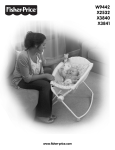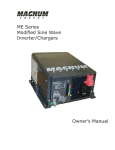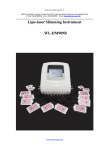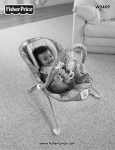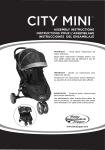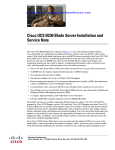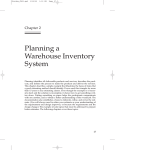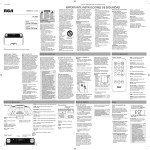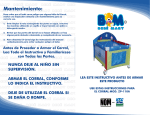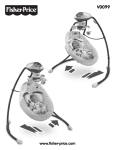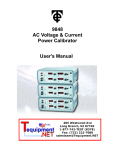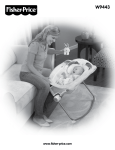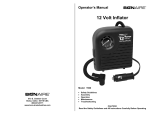Download fisher-price.com
Transcript
BCG43, BCG44, BCT91, BHL58, BHV55, BHV56, BHV57, BHV58, BGB04, BGB05, BMC93, BMH13, BMH14, BMM25, BMM97 IMPORTANT! Please keep these instructions for future reference. Please read these instructions before assembly and use of this product. • Adult assembly is required. Assembly instructions on back side of this sheet. • Requires one D (LR20) alkaline battery (not included) for soothing unit. • Tool required for battery installation: Phillips screwdriver (not included). • Product features and decorations may vary from photographs. ¡IMPORTANTE! Guardar estas instrucciones para futura referencia. Leer estas instrucciones antes de ensamblar y usar este producto. • Requiere montaje por un adulto. Ver el dorso de esta hoja para las instrucciones de montaje. • La unidad relajante funciona con 1 pila alcalina D (LR20) x 1,5V (no incluida). • Herramienta necesaria para el montaje: desatornillador de cruz (no incluido). • Las características y decoración del producto pueden variar de las mostradas. • LEA LAS INSTRUCCIONES ANTES DE USAR ESTE PRODUCTO. fisher-price.com Soothing Unit Unidad relajante CONSUMER ASSISTANCE AYUDA AL CONSUMIDOR 1-800-432-5437 (US) Fisher-Price, Inc., 636 Girard Avenue, East Aurora, NY 14052. Hearing-impaired consumers/Clientes con problemas auditivos 1-800-382-7470. Centro de Servicio en México: 59-05-51-00 Ext. 5206 ó 01-800-463-59-89 MÉXICO Importado y distribuido por Mattel de México, S.A. de C.V., Miguel de Cervantes Saavedra No. 193, Pisos 10 y 11, Col. Granada, Delegación Miguel Hidalgo, C.P. 11520, México, D.F. R.F.C. MME-920701-NB3. • Make sure your child is properly secured in the seat. • Slide the power switch to: Vibrations or Off O. IMPORTANT! Low battery power may cause this product to operate erratically: no vibrations and the product may not turn off. Remove and discard the battery and replace with a new D (LR20) alkaline battery. CHILE Mattel Chile, S.A., Avenida Américo Vespucio 501-B, Quilicura, Santiago. Tel.: 1230-020-6213. VENEZUELA Servicio al consumidor Venezuela: Tel.: 0-800-100-9123. ARGENTINA Mattel Argentina, S.A., Curupaytí 1186, (1607) – Villa Adelina, Buenos Aires. Tel.: 0800-666-3373. COLOMBIA Mattel Colombia, S.A., Calle 123#7-07 P.5, Bogotá. Tel.: 01800-710-2069. • Asegurarse de que el niño esté bien asegurado en la silla. • Poner el interruptor de encendido en: Vibraciones o Apagado O. ¡IMPORTANTE! Si la pila está gastada, el producto no funcionará correctamente (sin vibraciones ni función de apagado). Sacar y descartar la pila y sustituirla por 1 pila nueva alcalina D (LR20) x 1,5V. PERÚ Mattel Perú, S.A., Av. Juan de Arona # 151, Centro Empresarial Juan de Arona, Torre C, Piso 7, Oficina 704, San Isidro, Lima 27, Perú. RUC: 20425853865. Reg. Importador: 02350-12-JUEDIGESA. Tel.: 0800-54744. Resto de Latinoamérica: [email protected]. ©2013 Mattel. All Rights Reserved. PRINTED IN CHINA 2 BCG43d-0821 WARNING Failure to follow these warnings and the instructions could result in serious injury or death. • ALWAYS use the restraint system. • ALWAYS use the pad provided, which includes the restraint. NEVER add a mattress, pillow, comforter, or padding. • SUFFOCATION HAZARD – Infants can suffocate: - in gaps between an extra pad and the side of the product. - on soft bedding. • FALL HAZARD – To prevent falls, DO NOT use this product when the infant begins to push up on hands and knees, can pull up or sit unassisted or has reached 25 lbs (11 kg), whichever comes first. • Strings can cause strangulation! NEVER place items with a string around a child’s neck such as hood strings or pacifier cords. NEVER suspend strings over product or attach strings to toys. • NEVER place product near a window where cords from blinds or drapes can strangle a child. • To reduce the risk of Sudden Infant Death Syndrome (SIDS), pediatricians recommend healthy infants be placed on their backs to sleep, unless otherwise advised by your physician. • Always provide the supervision necessary for the continued safety of your child. • When used for playing, never leave child unattended. 3 ADVERTENCIA El incumplimiento de estas advertencias e instrucciones puede resultar en lesiones graves o la muerte. • SIEMPRE usar el sistema de sujeción. • SIEMPRE usar la almohadilla proporcionada que incluye el sistema de sujeción. NO añadir un colchón, almohada, edredón o almohadilla. • PELIGRO DE ASFIXIA – Los niños pequeños se pueden asfixiar: - En los espacios entre un colchón adicional y el lado del producto. - En ropa de cama suave. • PELIGRO DE CAÍDAS – Para evitar caídas, NO usar este producto cuando el bebé empiece a incorporarse por sí solo con las manos y rodillas, se pare impulsándose con las manos, se siente por sí solo o llegue a pesar 11 kg, lo que ocurra primero. • ¡Los cordones pueden causar estrangulación! NO poner artículos con cordones, tales como capuchas o chupones, alrededor del cuello del niño. NO suspender cordones sobre el producto ni amarrar cordones a los juguetes. • NO poner el producto cerca de una ventana donde los cordones de las persianas o cortinas pueden estrangular al niño. • Para reducir el riesgo de síndrome de muerte súbita del lactante (SMSL), los pediatras recomiendan acostar a dormir a los bebés sanos boca arriba, salvo que se indique lo contrario por un médico. • Para seguridad del niño, siempre usar bajo la vigilancia de un adulto. • Cuando se use para jugar, no dejar al niño fuera de su alcance. 4 Securing Your Child Waist Belt Waist Belt Cinturón Cinturón Sistema de sujeción • Asegurarse de que el sistema de sujeción esté bien asegurado, jalándolo en dirección opuesta al niño. El sistema de sujeción debe permanecer conectado. 2 LOOSEN AFLOJAR To tighten the waist belts: • Feed the anchored end of the waist belt up through the buckle to form a loop A. Pull the free end of the waist belt B. To loosen the waist belts: • Feed the free end of the waist belt up through the buckle to form a loop A. Enlarge the loop by pulling on the end of the loop toward the buckle. Pull the anchored end of the waist belt to shorten the free end of the waist belt B. Crotch Pad 1 TIGHTEN APRETAR Almohadilla de la entrepierna • Place your child in the seat. • Position the crotch pad between your child’s legs. • Fasten both waist belts to the crotch pad. Make sure you hear a “click” on both sides. • Tighten each waist belt so that the restraint system is snug against your child. Please refer to the next section for instructions to tighten the waist belts. • Check to be sure the restraint system is securely attached by pulling it away from your child. The restraint system should remain attached. Para apretar los cinturones: • Introducir el extremo fijo del cinturón en la hebilla para formar un espacio A. Jalar el extremo libre del cinturón B. Para aflojar los cinturones: • Introducir el extremo libre del cinturón en la hebilla para formar un espacio A. Agrandar el espacio jalando el extremo del cinturón hacia la hebilla. Jalar el extremo fijo del cinturón para acortar el extremo libre del cinturón B. • Sentar al niño en el asiento. • Colocar la almohadilla de la entrepierna entre las piernas del niño. • Ajustar ambos cinturones en la almohadilla de la entrepierna. Asegurarse de oír un clic en ambos lados. • Apretar cada cinturón de modo que el sistema de sujeción quede bien ajustado al niño/a. Consultar la siguiente sección para mayores detalles sobre cómo apretar los cinturones. 5 Preventing Baby’s Head from Flattening Cómo evitar que la cabeza del bebé se aplane • Try tummy time two or three times a day, for short periods of time, until your baby gets used to being on her tummy. Once your baby begins to enjoy this position, try longer periods of time or increase the frequency of tummy time play. • Help your baby avoid resting his head in the same position all the time by frequently changing the direction he lies in the crib. For example, have your baby’s feet point toward one end of the crib for a few days, and then change the position so his feet point toward the other end of the crib. This will encourage your baby to turn and look in different directions. • Try to minimize the amount of time your baby spends in car seats, carriers and bouncy seats while awake. • Lastly, make sure you enjoy lots of “cuddle time” with your baby by holding her upright over your shoulder. For additional information on positional plagiocephaly and the benefits of tummy time play for your baby, speak with your pediatrician or family physician. Pediatricians and child health organizations agree that healthy babies should be placed on their backs to sleep for naps and at nighttime, to reduce the risk of Sudden Infant Death Syndrome (SIDS). But babies who are always on their backs can sometimes develop flat spots on their head (plagiocephaly). Most cases of positional plagiocephaly can be prevented (and sometimes corrected) by repositioning your baby to relieve pressure on the back of the head. Here are some tips and techniques from the experts to keep in mind as you care for your baby: • Change the location of your baby’s sleeper or crib in the room, so she has to look in different directions to see the door, or the window, or interesting things going on around her. • When your baby is awake, provide opportunities for adult-supervised “tummy time” play. Playing on his tummy helps take the pressure off the back of his head, which will help prevent flat spots from developing. Tummy time play also helps your baby’s head, neck and shoulder muscles get stronger as part of normal development. National Institute of Health (NIH) Eunice Kennedy Shriver National Institute of Child Health and Human Development 6 Preventing Baby’s Head from Flattening Cómo evitar que la cabeza del bebé se aplane Tanto pediatras como organizaciones de salud de niños están de acuerdo en que los bebés sanos deben dormir siestas y periodos más largos boca arriba para reducir el riesgo de síndrome de muerte súbita infantil. Sin embargo, los bebés que siempre están boca arriba, a veces pueden desarrollar plagiocefalia (aplanamiento de la cabeza). La mayoría de casos de plagiocefalia posicional puede ser prevenida (y a veces corregida) reposicionado al bebé para aliviar la presión en el dorso de la cabeza. A continuación se presentan consejos y técnicas de los peritos para el cuidado del bebé: • Cambia la ubicación de la camita o cuna del bebé en el cuarto de modo que, para ver la puerta, ventana o algún otro objeto de interés, tenga que ver en diferentes direcciones. • Cuando el bebé esté despierto, date tiempo para jugar boca abajo con él/ella. Jugar boca abajo ayuda a quitar la presión del dorso de la cabeza y ayuda a prevenir el aplanamiento. Jugar boca abajo también ayuda a fortalecer los músculos de la cabeza, cuello y hombros del bebé como parte de un desarrollo normal. • Juega boca abajo dos o tres veces al día, por periodos breves, hasta que el bebé se acostumbre a estar boca abajo. Ya que el bebé esté a gusto en esta posición, aumenta los periodos de tiempo o la frecuencia del juego boca abajo. • Ayuda al bebé a evitar apoyar su cabeza en la misma posición todo el tiempo, cambiando con frecuencia la dirección en la que está acostado/a en la cuna. Por ejemplo, por unos días, apunta los pies del bebé hacia un extremo de la cuna y, luego, cambia la posición de los pies hacia el otro extremo de la cuna. Esto estimulará al bebé a voltearse y ver en diferentes direcciones. • Intenta minimizar la cantidad de tiempo que el bebé pasa en asientos de auto, cargadores y sillas de rebote mientras está despierto/a. • Por último, asegúrate de pasar mucho tiempo con el bebé en brazos, cargándolo con la cabeza derecha sobre tu hombro. Habla con el pediatra o médico para obtener más información sobre plagiocefalia posicional y los beneficios para el bebé de jugar boca abajo. Instituto Nacional de Salud (NIH) Instituto Nacional de Salud de Niños y Desarrollo Humano Eunice Kennedy Shriver 7 Storage Almacenamiento To Remove the Pad Para quitar la almohadilla PUSH EMPUJAR Unfasten PRESS Desajustar PRESIONAR PUSH EMPUJAR PRESS PRESIONAR Unbuckle Desabrochar • Press the button on each hub and push the liner tubes together. • Lean against a wall for storage. • Unbuckle the restraint system. Unfasten the pad button holes from the liner brackets. Unbuckle the straps on the pad. Pull the pad off the fasteners. Pull the restraint system down through the slots in the pad. Remove the pad from the liner. • To replace the pad, follow the assembly instructions. • Presionar el botón de cada conexión y unir los tubos del forro empujándolos. • Apoyar el producto contra una pared para guardarlo. • Desabrochar el sistema de sujeción. Desajustar los orificios de botón de la almohadilla de las abrazaderas del forro. Desabrochar los cinturones de la almohadilla. Separar la almohadilla de los sujetadores. Jalar hacia abajo el sistema de sujeción por las ranuras de la almohadilla. Quitar la almohadilla del forro. • Para regresar la almohadilla a su lugar, seguir las instrucciones de montaje. • Protect the environment by not disposing of this product with household waste (2002/96/EC). Check your local authority for recycling advice and facilities. • Ayúdenos a proteger el medio ambiente y no tire este producto en la basura doméstica (2002/96/EC). Para más información sobre la eliminación correcta de residuos, contactar con la Junta de Residuos o el Ayuntamiento de su localidad. 8 Assembled Parts Piezas ensambladas Assembly Montaje IMPORTANT! Before assembly and each use, inspect this product for damaged hardware, loose joints, missing parts or sharp edges. DO NOT use if any parts are missing or broken. Contact Fisher-Price® for replacement parts and instructions if needed. Never substitute parts. Hint: You may need the help of another adult to steady the product during assembly steps 1-4. Liner Forro ¡IMPORTANTE! Antes del montaje y de cada uso, revisar que el producto no tenga piezas dañadas, conexiones sueltas, piezas faltantes o bordes filosos. NO usar el producto si falta o está rota alguna pieza. Póngase en contacto con la oficina Mattel más próxima a su localidad para obtener piezas de repuesto e instrucciones, en caso de ser necesarias. Visite http://service.mattel.com/intl/es.asp para un listado completo. No usar piezas de terceros. Atención: Pida la ayuda de otra persona para mantener el producto estable durante los pasos de montaje 1 a 4. 2 Hubs 2 conexiones Pad Almohadilla 2 Base Tubes 2 tubos de base 9 Assembly Montaje Hub Tubes Hub Tubos con conexión Conexión Base Tube Tubo de la base 1 • Fit the end of one of the base tubes into a tube on one of the hubs, as shown. Hint: Each hub is designed to fit on the base tubes one way. If one of the hub tubes does not seem to fit, try the other tube. 3 • Fit the ends of the remaining base tube into the free ends of the hub tubes. Hint: Each hub is designed to fit onto the base one way. If either base tube does not seem to fit, turn the base tube around and try again! • Insertar el extremo de uno de los tubos de base en un tubo en una de las conexiones, tal como se muestra. Atención: Cada conexión está diseñada para ajustarse en los tubos de base de una sola manera. Si uno de los tubos con conexión no se ajusta, intentar montarlo en el otro tubo. • Insertar los extremos del tubo de base restante en los extremos libres de los tubos de la conexión. Atención: Cada conexión está diseñada para ajustarse en la base de una sola manera. Si no se ajustan, voltear la base e intentar de nuevo. 2 • Fit the other end of the base tube into a tube on the remaining hub, as shown. • Insertar el otro extremo del tubo de base en un tubo en la conexión restante, tal como se muestra. 10 Assembly Montaje Liner Tubes Tubos del forro Liner Forro PULL JALAR PRESS PRESIONAR PULL JALAR PRESS PRESIONAR 5 4 • Press the button on each hub and pull apart the liner tubes. • Make sure you hear a "click" on each end. • Fit the liner tubes onto the hub tubes. Hint: The liner is easier to assemble if the base remains in the folded position. • Presionar el botón de cada conexión y separar los tubos del forro. • Asegurarse de oír un clic en cada extremo. • Ajustar los tubos del forro en los tubos de la conexión. Atención: Es más fácil montar el forro si la base permanece en posición plegada. 11 Assembly Montaje Pad Button Holes Orificios de botón de la almohadilla Waist Belt Waist Belt Cinturón de la cintura Warning Label (not visible) Etiqueta de advertencia (no visible) Cinturón de la cintura Slots Ranuras 7 • Fold the top of the pad down and insert the waist belts through the slots in the pad. Make sure the waist belts are not twisted. Soothing Unit Unidad relajante • Doblar hacia abajo la parte de arriba de la almohadilla e insertar los cinturones en las ranuras de la almohadilla. Asegurarse de que los cinturones no estén torcidos. 6 • Position the pad so that the button holes are toward the warning label on the liner. Place the pad on the liner. • Fit the edges of the soothing unit through the large opening the pad. • Colocar la almohadilla de modo que los orificios de botón apunten hacia la etiqueta de advertencia en el forro. Poner la almohadilla sobre el forro. • Ajustar los bordes de la unidad relajante en el orificio grande de la almohadilla. 12 Assembly Montaje Liner Bracket (not visible) Abrazadera del forro (no visible) Button Hole Button Hole (not visible) Orificio de botón Orificio de botón (no visible) Straps 9 Liner Bracket Cinturones • Pull the bottom of the pad around the liner. • Buckle the straps on the pad. Make sure you hear a "click". Abrazadera del forro 8 • Jalar la parte inferior de la almohadilla alrededor del forro. • Abrochar los cinturones de la almohadilla. Asegurarse de oír un clic. • Fold the top of the pad up to fit it back into the liner. • Fit the button holes on the pad around the brackets on the liner. • Doblar hacia arriba la parte de arriba de la almohadilla para volver a ajustarla en el forro. • Ajustar los orificios de botón de la almohadilla alrededor de las abrazaderas del forro. PRESS PRESIONAR 10 • Press the pad edges onto the fasteners on the liner. • Presionar los bordes de la almohadilla en los sujetadores del forro. 13 Battery Installation Colocación de las pilas • Remove rechargeable batteries from the product before charging. • If removeable, rechargeable batteries are used, they are only to be charged under adult supervision. 1,5V D (LR20) Soothing Unit • Loosen the screw in the battery compartment door with a Phillips screwdriver. Remove the battery compartment door. • Insert one D (LR20) alkaline battery into the battery compartment. • Replace the battery compartment door and tighten the screw. • If this product begins to operate erratically, you may need to reset the electronics. Slide the power switch off and then back on. Battery Safety Information In exceptional circumstances, batteries may leak fluids that can cause a chemical burn injury or ruin your product. To avoid battery leakage: • Do not mix old and new batteries or batteries of different types: alkaline, standard (carbon-zinc) or rechargeable (nickel-cadmium). • Insert batteries as indicated inside the battery compartment. • Remove batteries during long periods of non-use. Always remove exhausted batteries from the product. Dispose of batteries safely. Do not dispose of product in a fire. The batteries inside may explode or leak. • Never short-circuit the battery terminals. • Use only batteries of the same or equivalent type as recommended. • Do not charge non-rechargeable batteries. Unidad relajante • Destornillar el tornillo de la tapa del compartimento de la pila con un desatornillador de cruz. Retirar la tapa. • Insertar 1 pila alcalina D (LR20) x 1,5V en el compartimento. • Cerrar la tapa del compartimento de la pila y apretar el tornillo. • Si este producto no funciona correctamente, restablecer los circuitos electrónicos. Poner el interruptor de encendido en apagado y nuevamente en encendido. Información de seguridad sobre las pilas En circustancias excepcionales, las pilas pueden derramar líquido que puede causar quemaduras o dañar el producto. Para evitar derrames: • No mezclar pilas nuevas con gastadas ni mezclar pilas alcalinas, estándar (carbono-cinc) o recargables (níquel-cadmio). • Cerciorarse de que la polaridad de las pilas sea la correcta. • Sacar las pilas gastadas del producto y desecharlas apropiadamente. Sacar las pilas si el producto no va a ser usado durante un periodo prolongado. No quemar las pilas ya que podrían explotar o derramar el líquido incorporado en ellas. • No provocar un cortocircuito con las terminales. • Usar sólo el tipo de pilas recomendadas (o su equivalente). • No cargar pilas no recargables. • Sacar las pilas recargables antes de cargarlas. • La carga de las pilas recargables sólo debe realizarse con la supervisión de un adulto. 14 Keep this product clean and dry! ¡Mantener este producto limpio y seco! Regular Care • During regular use, the pad and the liner may become damp. Periodically remove the pad from the liner to air-out and prevent moisture buildup. • We also recommend machine washing the pad once a week (or each time they becomes soiled). Machine wash separately in cold water with a mild detergent on the gentle cycle. Do not use bleach for routine washing. Tumble dry on low. • While laundering the pad, clean the liner and frame with a mild solution of liquid detergent and water. Do not use abrasive cleaners. Rinse thoroughly with clean water to remove soap residue. Pat dry with a towel and air dry completely before replacing the pad on the liner. Advanced Care • Moisture buildup may lead to mildew. If you see mildew on your pad or liner, follow these instructions to kill mildew. Pad • Machine wash separately in cold water with a mild detergent and ¼ cup (0,06 liters) bleach. Use the highest water setting on the gentle cycle and tumble dry on low. Use of bleach may result in some color loss of the fabric. Liner • Place the product on a protected surface in a well-ventilated room. • Mix 1 gallon (about 4 liters) of water with 1½ cups (0,35 liters) of chlorine bleach. Apply with a sponge and wipe to clean. Be sure to wear gloves and protective eye wear and clothing when cleaning with bleach. Never mix bleach with ammonia or other household cleaners. Use of bleach may result in some color loss of the fabric. Rinse thoroughly with clean water. • After cleaning with bleach and water, wash the liner using a small amount of liquid detergent. Gently scrub with a soft brush. Rinse thoroughly with clean water. • Pat dry with a towel and air dry completely before replacing the pad on the liner. For more cleaning information, please contact Fisher-Price® Consumer Relations at service.fisher-price.com or call 1-800-432-5437. 15 Keep this product clean and dry! ¡Mantener este producto limpio y seco! Mantenimiento regular • Con el uso normal del producto, la almohadilla y forro pueden humedecerse. Quitar periódicamente la almohadilla del forro para orear el producto y evitar la acumulación de humedad. • Recomendamos lavar a máquina la almohadilla una vez a la semana (o cada vez que se ensucie). Lavarla a máquina por separado en agua fría con un detergente neutro en ciclo delicado. Para lavados normales, no usar blanqueador. Meter a la secadora a temperatura baja. • Mientras se lava la almohadilla, limpiar el forro y el armazón con una solución neutra de detergente líquido y agua. No usar limpiadores abrasivos. Enjuagar por completo con agua limpia para eliminar el residuo de jabón. Secarlo inicialmente con una toalla y dejar que se seque al aire por completo antes de colocar la almohadilla en el forro. Mantenimiento avanzado • La acumulación de humedad puede crear moho. Si nota moho en la almohadilla o forro, seguir estas instrucciones para eliminarlo. Almohadilla • Lavarlos a máquina por separado en agua fría con un detergente neutro y ¼ de taza (0,06 litros) de blanqueador. Usar el nivel de agua más alto en el ciclo delicado y secar a temperatura baja. El uso de blanqueador puede causar que la tela se decolore un poco. Forro • Colocar el producto sobre una superficie protegida en un cuarto bien ventilado. • Mezclar 4 litros de agua con 1½ tazas (0,35 litros) de blanqueador. Usar una esponja para limpiarlo. Asegurarse de usar guantes y anteojos protectores y ropa al limpiar con blanqueador. No mezclar blanqueador con amoníaco u otros desinfectantes caseros. El uso de blanqueador puede causar que la tela se decolore un poco. Enjuagar por completo con agua limpia. • Después del lavado con blanqueador y agua, lavar el forro con una cantidad pequeña de detergente líquido. Cepillar suavemente con un cepillo suave. Enjuagar por completo con agua limpia. • Secarlo inicialmente con una toalla y dejar que se seque al aire por completo antes de colocar la almohadilla en el forro. Para más información sobre el lavado, en los EE.UU., contactarse con el Departamento de atención al cliente de Fisher-Price en service.fisher-price.com o llamar al 1-800-432-5437. Fuera de los EE.UU., consultar la guía telefónica para un listado de Mattel. 16


















